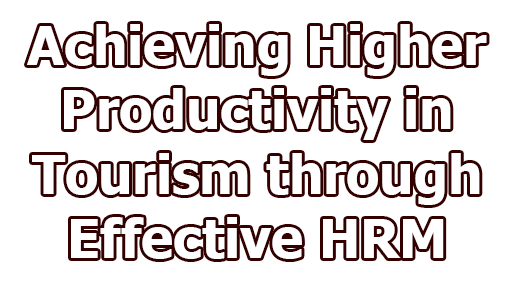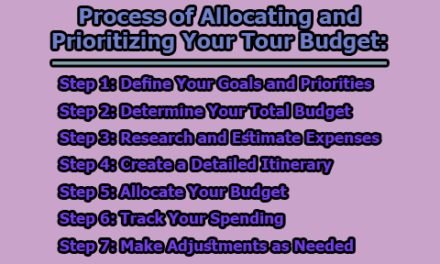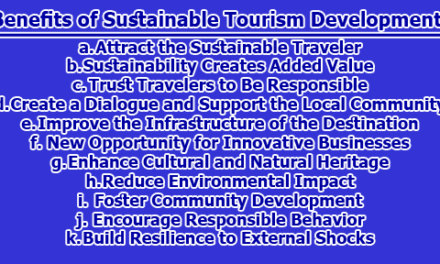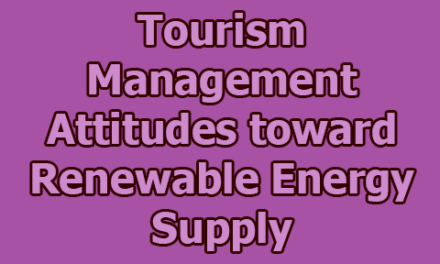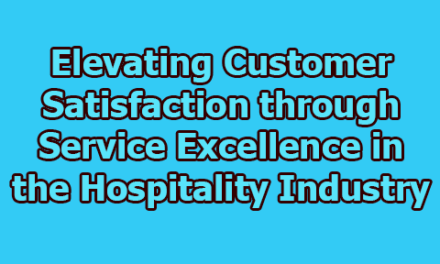Achieving Higher Productivity in Tourism through Effective HRM:
The tourism industry is a cornerstone of many economies, providing jobs and driving economic growth. However, it is also a sector that faces unique challenges related to seasonality, customer service, and workforce management. In the rest of this article, we will explore the following statement, “Achieving Higher Productivity in Tourism through Effective HRM”.
1. The Importance of HRM in Tourism:
The tourism industry is not just a sector; it’s a dynamic economic force that significantly contributes to global employment and economic growth. According to the World Travel & Tourism Council (WTTC) in 2019, “the travel and tourism sector accounted for a staggering 10.4% of global GDP and provided employment to 319 million individuals, encompassing both direct, indirect, and induced jobs”. In light of its labor-intensive nature and the paramount importance of service quality, it’s imperative to recognize that Human Resource Management (HRM) serves as the linchpin for the triumph and sustainability of the tourism industry.
1.1 Workforce as the Heart of Tourism: In the context of tourism, the human element is not just a valuable asset; it’s the very essence of the product. Unlike manufacturing industries where tangible goods are the primary output, tourism offers an intangible experience, and the individuals who deliver this experience are the industry’s most precious resource. Frontline employees—comprising hotel staff, tour guides, restaurant servers, and travel agents—engage directly with tourists, shaping their perceptions and influencing their satisfaction levels. These interactions have the power to make or break a tourist’s experience, underscoring the pivotal role that employees play in the tourism industry’s success (Goeldner & Ritchie, 2006).
1.2 Service Quality and Customer Satisfaction: Service quality stands as a cornerstone of customer satisfaction within the tourism sector. Numerous studies have affirmed the direct link between service quality and customer satisfaction (Parasuraman et al., 1988). Exceptional service quality not only leads to positive reviews but also fosters repeat business and encourages word-of-mouth recommendations—vital factors for tourism businesses seeking to thrive in a competitive market.
1.3 Talent Acquisition and Recruitment: The HRM journey in tourism commences with the art of attracting and recruiting the right talent. Whether it’s finding seasonal staff for a picturesque beach resort or permanent employees for a bustling city hotel, the process of hiring individuals who resonate with the organization’s culture and embody its customer-centric values is paramount (Kusluvan et al., 2010).
1.4 Training and Development: The rapid evolution of the tourism industry necessitates continuous training and development programs for its workforce. Effective HRM entails the creation and implementation of training initiatives that enhance employees’ competencies, instill a service-oriented mindset, and ensure they remain updated on industry trends (Woods & Williams, 2007).
1.5 Workforce Management and Flexibility: One of the industry’s distinctive characteristics is its susceptibility to seasonal fluctuations in demand. HRM professionals face the challenge of managing a flexible workforce capable of adapting to these variations. Strategies for hiring seasonal staff, optimizing shift schedules, and harmonizing labor costs with service quality are essential to ensure that the right number of employees is available at the right time and place (Baum & Hagen, 1999).
1.6 Employee Engagement and Retention: High turnover rates can have a detrimental impact on any business, but they are particularly costly within the tourism sector. HRM practices that nurture employee engagement, such as recognition programs, avenues for career advancement, and a positive workplace culture, significantly contribute to staff retention. Engaged employees are not only more likely to provide excellent customer service but also play a pivotal role in boosting the organization’s overall productivity (Saks, 2006).
1.7 Performance Management and Appraisals: Effective performance management processes provide employees with regular feedback on their performance, identify areas for improvement, and set clear performance goals. In the context of tourism, this ensures that employees are aligned with organizational objectives, motivated to excel in their roles, and have the means to continuously enhance their service delivery (Armstrong & Baron, 2005).
2. Talent Acquisition and Recruitment in Tourism:
Talent acquisition and recruitment are fundamental HRM functions in the tourism industry. In an industry characterized by diverse roles and seasonal fluctuations, attracting and selecting the right talent is essential for delivering exceptional service, ensuring customer satisfaction, and sustaining a competitive advantage. This section delves into the significance of talent acquisition and recruitment in tourism, key strategies, challenges, and best practices.
2.1 The Significance of Talent Acquisition in Tourism:
- Customer-Centric Nature: Tourism is inherently customer-centric. The individuals who interact with tourists, such as hotel staff, tour guides, and restaurant servers, significantly influence the quality of the customer experience. Therefore, hiring the right people with the right attitude and skills is paramount (Kusluvan et al., 2010).
- Seasonal Demands: Many tourism businesses experience seasonal variations in demand. In such cases, talent acquisition strategies must account for the need to hire and onboard a flexible workforce during peak seasons and scale down during off-peak times.
- Global Talent: Tourism often attracts a diverse workforce from around the world. Effective talent acquisition strategies should be inclusive and consider cultural diversity as an asset in delivering a more personalized experience to tourists (Kusluvan et al., 2010).
2.2 Key Strategies for Talent Acquisition in Tourism:
- Attractive Job Descriptions: Craft compelling job descriptions that highlight the unique aspects of working in the tourism industry. Emphasize the opportunity to interact with travelers, provide exceptional service, and be part of a dynamic and multicultural environment.
- Leveraging Technology: Use technology to reach a global audience of potential candidates. Online job portals, social media, and digital recruitment platforms can help connect with talent worldwide (Baum & Hagen, 1999).
- Data-Driven Recruitment: Analyze data and trends to make informed hiring decisions. Understand which roles experience seasonal fluctuations in demand and plan recruitment accordingly.
- Values and Culture Alignment: Emphasize organizational values and culture during recruitment. Seek candidates who align with these values and can embody the organization’s commitment to customer service.
2.3 Challenges in Talent Acquisition in Tourism:
- High Turnover: The transient nature of some tourism roles can result in high turnover rates. Continuous recruitment efforts are necessary to maintain a stable workforce.
- Competition for Talent: The tourism industry is competitive, with multiple businesses vying for the same talent pool. Attracting top talent may require innovative recruitment strategies (Kusluvan et al., 2010).
- Language and Cultural Barriers: In regions with international tourism, language and cultural differences can pose challenges in hiring and managing a diverse workforce.
2.4 Best Practices in Recruitment:
- Clear Communication: Provide clear and transparent communication during the recruitment process. Candidates should understand job expectations, work conditions, and any seasonal or contractual arrangements.
- Behavioral Interviews: Conduct behavioral interviews that assess candidates’ soft skills and cultural fit. Ask situational questions to gauge their ability to handle real-world scenarios.
- Employee Referral Programs: Encourage current employees to refer potential candidates. This can be an effective way to attract individuals who align with the organization’s values and culture.
- Onboarding and Training: Develop robust onboarding processes to help new hires acclimate to the organization and their roles. Effective training programs can shorten the learning curve and improve employee performance.
3. Training and Development for Tourism Employees:
In the fast-paced and ever-evolving tourism industry, employee training and development are critical components of success. Tourism businesses that invest in their workforce’s growth and skills not only enhance service quality but also improve employee satisfaction and retention. In this section, we explore the importance of training and development for tourism employees, discussing key practices, methods, and their impact.
3.1 Importance of Training and Development:
- Adaptation to Industry Changes: The tourism industry is highly susceptible to changing customer preferences, technological advancements, and market trends. Regular training programs keep employees updated and adaptable to these shifts, ensuring they can provide current and relevant services (Woods & Williams, 2007).
- Service Excellence: Service quality is paramount in tourism. Well-trained employees are better equipped to meet or exceed customer expectations, resulting in higher levels of customer satisfaction and loyalty.
- Enhanced Employee Morale: Providing opportunities for skill development and career growth boosts employee morale. Engaged and motivated staff are more likely to deliver exceptional service (Saks, 2006).
- Reduction in Employee Turnover: Employees who see a clear path for advancement within the organization are more likely to stay. This reduces turnover costs and maintains a stable, experienced workforce (Kusluvan et al., 2010).
3.2 Effective Training and Development Practices:
- Needs Assessment: The training process should begin with a thorough needs assessment. Identify skills gaps and areas for improvement among employees. This helps tailor training programs to address specific needs.
- Clear Objectives: Define clear and measurable training objectives. Employees should understand what they are expected to learn and achieve through training.
- Interactive Training Methods: Incorporate interactive and hands-on training methods. Role-play, simulations, and real-world scenarios can help employees practice and apply their skills effectively.
- Customization: Recognize that different roles within the tourism sector may require different types of training. Customizing training programs to suit specific job roles ensures relevance and effectiveness.
- Technology Integration: Leverage technology for training purposes. E-learning platforms, webinars, and mobile apps can provide convenient and efficient ways to deliver training content (Woods & Williams, 2007).
3.3 Measuring the Impact of Training and Development:
- Feedback and Evaluation: Collect feedback from employees and trainers to assess the training program’s quality and relevance. Use evaluations to make improvements.
- Performance Metrics: Track key performance metrics before and after training. This can include customer satisfaction scores, employee productivity, and service quality indicators.
- Observation and Assessment: Observe employees on the job to assess the application of newly acquired skills. Provide constructive feedback and support as needed.
- ROI Analysis: Conduct a return on investment (ROI) analysis to determine the cost-effectiveness of training programs. Assess whether the benefits in terms of improved service quality and customer satisfaction outweigh the costs (Armstrong & Baron, 2005).
3.4 Case Study: Marriott International: Marriott International, a global leader in the hospitality industry, exemplifies the significance of training and development for tourism employees. The company offers extensive training programs for its staff, encompassing a wide range of skills, from customer service to technical competencies. These programs are delivered through a combination of classroom training, e-learning modules, and on-the-job coaching.
Marriott’s commitment to training not only ensures that its employees provide exceptional service but also contributes to the company’s reputation for excellence in hospitality. The Marriott Bonvoy training program, for example, focuses on creating personalized and memorable guest experiences. This aligns with the company’s core values of putting people first and delivering outstanding service (Marriott International, 2021).
4. Workforce Management Strategies in Tourism:
Workforce management is a critical aspect of HRM in the tourism industry, where demands fluctuate seasonally, and customer service quality is paramount. Successful workforce management strategies enable businesses to optimize staffing, meet customer needs, control labor costs, and enhance overall productivity. This section explores the importance of workforce management in tourism, key strategies, challenges, and best practices.
4.1 The Importance of Workforce Management in Tourism:
- Seasonal Demand: Tourism often experiences significant seasonal variations in customer demand. For example, beach resorts may be inundated with tourists during the summer but quieter in the off-season. Effective workforce management strategies must account for these fluctuations (Baum & Hagen, 1999).
- Flexible Scheduling: Tourism businesses must implement flexible scheduling practices to ensure they have the right number of employees available during peak times while avoiding overstaffing during off-peak periods.
- Multi-Skilling: Cross-training employees to perform multiple roles can help manage staffing requirements more efficiently. Multi-skilled employees can fill in gaps during peak periods or cover for absent colleagues (Baum & Hagen, 1999).
4.2 Key Workforce Management Strategies in Tourism:
- Demand Forecasting: Accurate demand forecasting is essential for workforce planning. Historical data, market trends, and seasonality patterns should be considered to predict staffing needs accurately.
- Flexible Work Arrangements: Offer flexible work arrangements such as part-time positions, temporary contracts, and seasonal employment to meet varying demand while minimizing labor costs.
- Cross-Training: Invest in cross-training employees to perform multiple roles. This not only provides flexibility in staffing but also enhances employee skills and job satisfaction.
- Technology Integration: Use technology, such as workforce management software, to automate scheduling, track employee hours, and optimize labor allocation (Woods & Williams, 2007).
4.3 Challenges in Workforce Management in Tourism:
- Labor Law Compliance: Complying with labor laws and regulations, which can vary by region and country, poses challenges for businesses operating in multiple locations.
- Balancing Costs: Finding the right balance between maintaining adequate staffing levels to ensure excellent service and controlling labor costs can be challenging.
- Staff Retention: High employee turnover, especially in seasonal positions, can hinder workforce management efforts. Retaining skilled employees can be a challenge.
4.4 Best Practices in Workforce Management:
- Regular Training: Provide ongoing training and development to ensure employees are equipped with the skills needed for their roles and potential cross-training opportunities.
- Employee Input: Involve employees in scheduling decisions where possible, taking into account their preferences and availability to enhance job satisfaction.
- Real-Time Monitoring: Utilize real-time monitoring tools to adjust staffing levels dynamically based on current demand patterns (Woods & Williams, 2007).
- Feedback Mechanisms: Establish mechanisms for employees to provide feedback on scheduling and workload. Their input can inform improvements in workforce management practices.
5. Employee Engagement and Retention in the Tourism Industry:
In the tourism industry, where customer satisfaction is pivotal, employee engagement and retention are critical factors for success. Engaged and satisfied employees are more likely to provide exceptional service, resulting in higher customer satisfaction, repeat business, and positive word-of-mouth recommendations. This section explores the significance of employee engagement and retention in tourism, strategies to foster them, challenges, and best practices.
5.1 The Significance of Employee Engagement and Retention in Tourism:
- Link to Customer Satisfaction: Engaged employees are more likely to go the extra mile to ensure customer satisfaction. Their enthusiasm and commitment directly impact the quality of the service provided (Saks, 2006).
- Knowledge and Experience: Retaining experienced employees is valuable in tourism, where expertise and familiarity with customer needs and expectations are crucial.
- Cost Savings: High employee turnover is costly in terms of recruitment, training, and lost productivity. Retaining skilled employees can significantly reduce these costs (Kusluvan et al., 2010).
- Positive Workplace Culture: Engaged employees contribute positively to workplace culture, fostering an environment of collaboration, creativity, and continuous improvement.
5.2 Strategies to Foster Employee Engagement and Retention:
- Recognition and Rewards: Implement recognition programs that acknowledge and reward outstanding performance and contributions. Incentives can include bonuses, awards, or opportunities for advancement.
- Career Development: Offer opportunities for career growth and advancement within the organization. Clear paths for promotion and skill development are essential for retaining ambitious employees.
- Work-Life Balance: Strive to provide work-life balance by offering flexible scheduling and paid time off. Employee well-being and personal time are essential for long-term engagement (Saks, 2006).
- Employee Involvement: Encourage employee involvement in decision-making processes. Seeking their input on matters that affect their roles and responsibilities can enhance job satisfaction.
5.3 Challenges in Employee Engagement and Retention:
- High Turnover in Seasonal Roles: Seasonal roles, common in tourism, often experience high turnover. Managing and retaining temporary or seasonal staff can be challenging.
- Competitive Labor Market: The tourism industry is competitive, and attracting and retaining talent can be difficult when other employers offer similar positions.
- Workforce Diversity: Managing a diverse workforce with different cultural backgrounds and languages can pose challenges in engagement and retention (Kusluvan et al., 2010).
5.4 Best Practices in Employee Engagement and Retention:
- Regular Feedback: Provide regular feedback and performance evaluations. Employees should understand their strengths and areas for improvement.
- Mentorship and Coaching: Implement mentorship and coaching programs to provide employees with guidance and support in their roles and career aspirations.
- Diversity and Inclusion: Promote diversity and inclusion in the workplace. Create an environment where all employees feel valued and included.
- Exit Interviews: Conduct exit interviews with departing employees to gain insights into their reasons for leaving and identify areas for improvement (Saks, 2006).
6. Performance Management and Appraisals in the Tourism Industry:
Performance management and appraisals play a pivotal role in the tourism industry, where service quality directly impacts customer satisfaction. Effectively managing and appraising employee performance is essential for maintaining service excellence, identifying areas for improvement, and aligning the workforce with organizational goals. This section delves into the significance of performance management and appraisals in tourism, key practices, challenges, and best strategies.
6.1 The Significance of Performance Management and Appraisals in Tourism:
- Service Quality: The tourism industry’s reputation hinges on service quality. Performance management ensures employees consistently meet or exceed service standards (Armstrong & Baron, 2005).
- Continuous Improvement: Appraisals identify strengths and areas for improvement, providing a basis for targeted training and development efforts.
- Goal Alignment: Performance management aligns individual employee goals with organizational objectives, ensuring a cohesive and productive workforce.
- Motivation: Regular feedback and recognition through appraisals can motivate employees to excel in their roles, leading to increased job satisfaction and engagement.
6.2 Key Practices in Performance Management and Appraisals:
- Clear Objectives: Establish clear and measurable performance objectives for employees. These objectives should align with the organization’s goals and values.
- Regular Feedback: Provide ongoing feedback rather than relying solely on annual reviews. Frequent, constructive feedback helps employees understand their performance and make necessary adjustments.
- Self-Assessment: Encourage employees to participate actively in the appraisal process by conducting self-assessments. This self-reflection can lead to more meaningful discussions during reviews (Armstrong & Baron, 2005).
- 360-Degree Feedback: Incorporate feedback from peers, subordinates, and supervisors in performance assessments to gain a comprehensive view of an employee’s strengths and areas for development.
6.3 Challenges in Performance Management and Appraisals:
- Seasonal Workforce: High turnover and seasonal employment can make it challenging to conduct consistent and comprehensive performance appraisals for all employees.
- Subjectivity: Appraisals are subjective, and biases can influence evaluations. Ensuring fairness and objectivity is a continuous challenge.
- Language Barriers: In regions with international tourism, language differences can complicate the appraisal process and lead to misunderstandings.
6.4 Best Practices in Performance Management and Appraisals:
- Training for Appraisers: Train supervisors and managers in conducting fair and unbiased appraisals. Provide them with the skills and tools needed to deliver constructive feedback.
- SMART Goals: Ensure that performance objectives are Specific, Measurable, Achievable, Relevant, and Time-bound (SMART). This clarity makes it easier to assess performance objectively.
- Employee Development Plans: Collaboratively develop development plans with employees based on their performance appraisals. This helps identify training needs and career growth opportunities (Armstrong & Baron, 2005).
- Regular Check-Ins: Conduct regular check-ins between formal appraisals to keep communication lines open and address performance issues promptly.
7. Challenges in Implementing Effective HRM in Tourism:
Implementing effective Human Resource Management (HRM) practices in the tourism industry comes with a unique set of challenges due to the industry’s characteristics, such as seasonality, workforce diversity, and customer-centricity. Addressing these challenges is essential for tourism businesses to attract, retain, and develop a skilled workforce that can consistently deliver high-quality service. In this section, we explore the challenges.
7.1 Seasonal Demand Fluctuations:
- Challenge: Many tourism destinations experience significant seasonal variations in customer demand. This requires HRM strategies to accommodate fluctuating workforce needs, from hiring seasonal workers during peak periods to managing staff reductions during off-peak times (Baum & Hagen, 1999).
- Solution: Develop flexible workforce planning models that account for seasonality. Offer temporary or part-time contracts to accommodate fluctuating demand while retaining core staff. Cross-train employees to fill multiple roles as needed.
7.2 Workforce Diversity:
- Challenge: The tourism industry often attracts a diverse workforce from various cultural backgrounds. Managing a multicultural team can be challenging, as language barriers, differing work styles, and cultural norms can impact communication and team cohesion (Kusluvan et al., 2010).
- Solution: Provide cultural sensitivity training for employees and managers to promote understanding and collaboration. Encourage diversity and inclusion within the workplace culture to leverage the strengths of a diverse team.
7.3 High Turnover Rates:
- Challenge: High turnover is common in the tourism industry, particularly in entry-level and seasonal positions. Frequent turnover can result in increased recruitment and training costs and disrupt service quality (Kusluvan et al., 2010).
- Solution: Implement effective retention strategies such as career development opportunities, employee recognition programs, and competitive compensation packages. Conduct exit interviews to gather insights into reasons for turnover and make necessary improvements.
7.4 Labor Law Compliance:
- Challenge: The tourism industry often operates across different regions and countries, each with its own labor laws and regulations. Ensuring compliance with these laws while managing a diverse workforce can be complex.
- Solution: Invest in legal expertise or HR professionals well-versed in local labor regulations. Maintain up-to-date HR policies and practices that align with the specific requirements of each location of operation.
7.5 Employee Burnout:
- Challenge: Tourism employees, especially those in customer-facing roles, may face high-stress situations and demanding schedules. This can lead to employee burnout, affecting job satisfaction and service quality.
- Solution: Implement workload management strategies, including proper shift scheduling and regular breaks. Offer stress management programs and encourage a healthy work-life balance. Employee assistance programs can provide support for those experiencing burnout (Saks, 2006).
7.6 Training Costs:
- Challenge: The need for continuous training and development in the tourism industry can incur substantial costs, both in terms of time and resources.
- Solution: Optimize training programs by utilizing e-learning platforms and incorporating on-the-job training whenever possible. Prioritize training that directly enhances customer service and aligns with business goals (Woods & Williams, 2007).
7.7 Technology Adoption:
- Challenge: The adoption of technology in HRM processes, such as workforce management software or e-recruitment systems, can be challenging for small or traditional tourism businesses.
- Solution: Gradually introduce technology solutions, ensuring that they align with the organization’s needs and can be easily integrated into existing HR processes. Provide training and support for employees adapting to new technologies (Woods & Williams, 2007).
8. Future Trends in HRM for Tourism:
The future of Human Resource Management (HRM) in the tourism industry is expected to be influenced by several emerging trends. As the industry evolves, HR professionals in tourism will need to adapt to these trends to attract, retain, and develop a skilled workforce that can meet the changing needs of travelers.
8.1 Technology Integration:
- Future Trend: The integration of technology will continue to shape HRM in tourism. Artificial intelligence (AI) and machine learning will be employed in recruitment, candidate screening, and workforce analytics (Foss & Lindgren, 2017).
- Impact: HR professionals will need to develop digital skills and utilize technology to streamline HR processes, enhance employee experiences, and leverage data-driven insights for better decision-making.
8.2 Remote and Flexible Work:
- Future Trend: The COVID-19 pandemic accelerated the adoption of remote and flexible work arrangements. This trend is likely to continue as employees seek work-life balance and employers recognize the benefits of remote work (Cullen et al., 2021).
- Impact: HRM in tourism will need to develop policies and practices that support remote work, maintain employee engagement, and ensure performance measurement in a virtual environment.
8.3 Focus on Employee Well-Being:
- Future Trend: Employee well-being will be a central concern in HRM. Mental health support, work-life balance initiatives, and wellness programs will be prioritized (Cullen et al., 2021).
- Impact: HR professionals in tourism will need to design and implement well-being programs to support employee mental and physical health, reducing burnout and enhancing job satisfaction.
8.4 Diversity, Equity, and Inclusion (DEI):
- Future Trend: DEI will gain prominence in HRM, reflecting the industry’s global nature. Organizations will strive for greater diversity and inclusivity in their workforce (Arias-Aranda et al., 2020).
- Impact: HRM in tourism will focus on diversity recruitment, training, and fostering inclusive workplace cultures to ensure equal opportunities and representation.
8.5 Gig and Seasonal Workforce Management:
- Future Trend: The gig economy will continue to influence the tourism industry. HR professionals will need to effectively manage gig and seasonal workers, ensuring their integration into the workforce (Davila & Campos, 2018).
- Impact: HRM in tourism will develop strategies to engage, train, and retain gig and seasonal workers while maintaining service quality.
8.6 Sustainability Initiatives:
- Future Trend: Sustainability will be a growing concern in HRM. Organizations in tourism will prioritize eco-friendly practices, and HR will play a role in promoting sustainability among employees (Sotiriadis & Gursoy, 2019).
- Impact: HR professionals will need to incorporate sustainability into talent attraction, training, and engagement strategies.
8.7 Skills Development and Reskilling:
- Future Trend: Continuous learning and skills development will be crucial. HR will focus on reskilling and upskilling employees to adapt to evolving job roles and industry demands (Nickson et al., 2013).
- Impact: HRM in tourism will create learning pathways, collaborate with educational institutions, and provide ongoing training to equip employees with future-ready skills.
8.8 Health and Safety Protocols:
- Future Trend: Health and safety concerns will persist post-pandemic. HRM will need to maintain and adapt health and safety protocols, ensuring employee and customer well-being (Osterhaus et al., 2020).
- Impact: HR professionals will be responsible for developing and communicating safety policies, training employees, and responding to health crises effectively.
In conclusion, achieving higher productivity in the tourism industry through effective HRM is not only a strategic imperative but also a driver of success in this dynamic sector. The tourism industry thrives on the exceptional service and experiences it provides to travelers, and a skilled, engaged, and well-managed workforce is at the heart of this endeavor. By implementing HRM practices that focus on employee development, engagement, and well-being, tourism businesses can create a positive work environment that not only boosts productivity but also enhances customer satisfaction, employee retention, and overall competitiveness. In an industry where success is measured by the smiles on travelers’ faces, HRM is the key to ensuring that those smiles are genuine and unforgettable.
References:
- Arias-Aranda, D., Martínez-Ruiz, M. P., & Izquierdo-Yusta, A. (2020). Cultural diversity and inclusiveness in the hotel industry: The role of human resource management practices. International Journal of Hospitality Management, 90, 102586.
- Armstrong, M., & Baron, A. (2005). Managing performance: Performance management in action. CIPD Publishing.
- Baum, T., & Hagen, L. (1999). Responses to seasonality: The experiences of peripheral destinations. International Journal of Tourism Research, 1(6), 382-392.
- Cullen, K. L., Edwards, B. D., Casper, W. C., & Gue, K. R. (2021). Employees’ adaptability and perceptions of technology use as predictors of engagement in flexible work arrangements. Journal of Applied Psychology, 106(1), 37-55.
- Davila, A., & Campos, J. (2018). The effects of gig work on worker well-being: Lessons from the gig economy. California Management Review, 61(2), 107-135.
- Foss, L., & Lindgren, R. (2017). The future of HRM–Implications for tourism and hospitality research. Tourism Review, 72(3), 343-347.
- Goeldner, C. R., & Ritchie, J. R. B. (2006). Tourism: Principles, practices, philosophies. John Wiley & Sons.
- Kusluvan, S., Kusluvan, Z., Ilhan, I., & Buyruk, L. (2010). The human dimension: A review of human resources management issues in the tourism and hospitality industry. Cornell Hospitality Quarterly, 51(2), 171-214.
- Marriott International. (2021). Training and Development.
- Nickson, D., Warhurst, C., Dutton, E., & Hurrell, S. A. (2013). Aesthetic labour, hospitality and gender. Annals of Tourism Research, 41, 170-190.
- Osterhaus, W., McPhail, R., & Greenwood, B. N. (2020). Organizational adaptation in an activist environment: Explaining the resilient sustainability efforts of major U.S. hotel chains. Academy of Management Journal, 63(2), 348-379.
- Parasuraman, A., Zeithaml, V. A., & Berry, L. L. (1988). SERVQUAL: A multiple-item scale for measuring consumer perceptions of service quality. Journal of Retailing, 64(1), 12-40.
- Saks, A. M. (2006). Antecedents and consequences of employee engagement. Journal of Managerial Psychology, 21(7), 600-619.
- Sotiriadis, M., & Gursoy, D. (2019). The role of training in adopting pro-environmental behaviors in hotels: A conservation of resources perspective. Tourism Management, 71, 147-159.
- WTTC (World Travel & Tourism Council). (2019). Economic Impact 2019.
- Woods, R. H., & Williams, P. (2007). Tourism e-service quality: A new research agenda. Tourism Management, 28(1), 154-167.

Former Student at Rajshahi University

